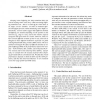Free Online Productivity Tools
i2Speak
i2Symbol
i2OCR
iTex2Img
iWeb2Print
iWeb2Shot
i2Type
iPdf2Split
iPdf2Merge
i2Bopomofo
i2Arabic
i2Style
i2Image
i2PDF
iLatex2Rtf
Sci2ools
AINA
2009
IEEE
2009
IEEE
Effects of On-path Buffering on TCP Fairness
Keeping router buffering low helps minimise delay (as well as keeping router costs low), whilst increasing buffering minimises loss. This is a trade-off for which there is no single ‘correct’ solution. In order to maintain effective throughput for TCP, whilst minimising router buffer requirements, current results suggest that different amounts of buffering are needed depending on the position in the network (e.g., edge or core), and on the relative capacity of ingress and egress links to a router. However, today we have several different variants of TCP in use, and each is designed to have different behaviour especially on paths with high bandwidth-delay product (BDP) values. We use a testbed to investigate the effects of different amounts of ‘onpath’ buffering (OPB) on the performance of four TCP variants – TCP NewReno, BIC, CUBIC, and Compound TCP – over various end-to-end round-trip-times (RTTs). Specifically, we consider how the variants respond when competing for ban...
Related Content
| Added | 09 Jul 2010 |
| Updated | 09 Jul 2010 |
| Type | Conference |
| Year | 2009 |
| Where | AINA |
| Authors | Saleem N. Bhatti, Martin Bateman |
Comments (0)

